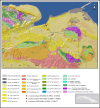Earliest evidence of sedentism in the Antilles: Multiple isotope data from Canímar Abajo, Cuba
- PMID: 39715435
- PMCID: PMC11725792
- DOI: 10.1073/pnas.2413963121
Earliest evidence of sedentism in the Antilles: Multiple isotope data from Canímar Abajo, Cuba
Abstract
The early populations that inhabited the Antilles were traditionally understood as highly mobile groups of hunters/fishers and gatherers. Although more recent data have demonstrated that some populations engaged in the production of domestic plants and cultivars, questions remain about other aspects of their lifeways, including whether the adoption of domesticates was accompanied by a decrease in residential mobility. The level of sedentism in a population is an instrumental variable to understand community social relations and complexity, adaptations, and lifeways. Here, we combined enamel strontium (87Sr/86Sr), oxygen (δ18Oen), and carbon (δ13Cen) isotopes of 44 human teeth from the site of Canímar Abajo-where the oldest human remains from the insular Caribbean have been reported-to examine the mobility patterns of early Antillean groups. In contrast with traditional narratives, the homogeneous strontium isotope values observed in most individuals from the older funerary area of the site (cal. BC 2237-790) were consistent with the pattern expected for a sedentary population subsisting primarily on local resources obtained close to the coast. The isotopic evidence reveals that between cal. AD 403-1282, the mound was reused for funerary practices by both local communities and nonlocal individuals. The evidence suggests that this period saw higher population mobility, with influxes of individuals from more distant locations and diverse dietary and burial traditions. The isotope results from Canímar Abajo provide the earliest isotopic evidence of populations with low-level residential mobility in the Antilles.
Keywords: Caribbean archaeology; archaic age lifeways; isotope analysis; mobility.
Conflict of interest statement
Competing interests statement:The authors declare no competing interest.
Figures


Similar articles
-
Diversity of Lifeways in Early Antillean Societies: A Multi-Isotope Approach.Am J Biol Anthropol. 2025 Apr;186(4):e70039. doi: 10.1002/ajpa.70039. Am J Biol Anthropol. 2025. PMID: 40241353 Free PMC article.
-
Home treatment for mental health problems: a systematic review.Health Technol Assess. 2001;5(15):1-139. doi: 10.3310/hta5150. Health Technol Assess. 2001. PMID: 11532236
-
The clinical effectiveness and cost-effectiveness of enzyme replacement therapy for Gaucher's disease: a systematic review.Health Technol Assess. 2006 Jul;10(24):iii-iv, ix-136. doi: 10.3310/hta10240. Health Technol Assess. 2006. PMID: 16796930
-
Cost-effectiveness of using prognostic information to select women with breast cancer for adjuvant systemic therapy.Health Technol Assess. 2006 Sep;10(34):iii-iv, ix-xi, 1-204. doi: 10.3310/hta10340. Health Technol Assess. 2006. PMID: 16959170
-
Direct composite resin fillings versus amalgam fillings for permanent posterior teeth.Cochrane Database Syst Rev. 2021 Aug 13;8(8):CD005620. doi: 10.1002/14651858.CD005620.pub3. Cochrane Database Syst Rev. 2021. PMID: 34387873 Free PMC article.
Cited by
-
Diversity of Lifeways in Early Antillean Societies: A Multi-Isotope Approach.Am J Biol Anthropol. 2025 Apr;186(4):e70039. doi: 10.1002/ajpa.70039. Am J Biol Anthropol. 2025. PMID: 40241353 Free PMC article.
References
-
- Tabío E., Rey E., Prehistoria de Cuba (Editorial Ciencias Sociales, La Habana, 1979).
-
- Alegría R. E., El uso de la terminología etno-histórica para designar las culturas aborígenes de las Antillas. Cuad. Prehisp. Vallad. 9, 5–32 (1981).
-
- Rouse I., The Tainos: Rise and Decline of the People who Greeted Columbus (Yale University Press, New Haven, 1992).
-
- Hofman C. L., Antczak A. T., Eds., Early Settlers of the Insular Caribbean: Dearchaizing the Archaic (Sidestone Press, Leiden, 2019).
-
- Rodríguez Ramos R., From the Guanahatabey to the Archaic of Puerto Rico: the non-evident evidence. Ethnohistory. 55, 393–415 (2008).
Publication types
MeSH terms
Substances
Grants and funding
LinkOut - more resources
Full Text Sources
Research Materials

